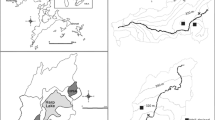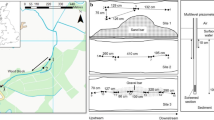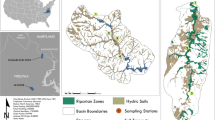Abstract
The Atchafalaya River Basin functions as a net sink for nitrogen delivered by the Mississippi and Red Rivers. Continued influx of river-borne sediment drives rapid habitat change on the floodplain, and lakes are transitioning to seasonally flooded baldcypress swamps and bottomland hardwood forests. As flooding regimes change, leading to more intermittent wet and dry cycles, soil conditions become more conducive to incomplete denitrification resulting in increased N2O emissions. The objective of this laboratory study was to determine if sediments in the Basin are potential sources of N2O emissions, and if emission rates differ among habitats types. Results indicate that potential N2O emission rates are low, and differ by habitat type. Lake sediments had the highest potential denitrification rates (53.68 g N2-N ha−1d−1), while baldcypress sediments had the highest potential N2O emissions (2.31 g N2O-N ha−1d−1). Unflooded bottomland hardwood sediments had very low denitrification potential and were not a source of N2O emissions, but emissions of both N2 and N2O increased after bottomland hardwood sediments were flooded. These results suggest that overall N2O emissions are low, but management strategies aiming to improve water quality and reduce greenhouse gas emissions should consider each habitat separately when modeling nitrogen removal within large floodplains.





Similar content being viewed by others
References
Burt TP, Matchett LS, Goulding WT, Webster CP, Haycock NE (1999) Denitrification in riparian buffer zones: the role of floodplain hydrology. Hydrol Process 13:1451–1463
DeLaune RD, Feijtel TC, Patrick WH (1989) Nitrogen flows in Louisiana Gulf Coast salt marsh: spatial considerations. Biogeochemistry 8:25–37
Dolda SK, Wang JJ, DeLaune RD, Cook RL (2008) Denitrification potential and its relation to organic carbon quality in three coastal wetland soils. Sci Total Environ 407:471–480
Faulkner SP, Bhattarai P, Allen Y, Barras J, Constant G (2009) Identifying baldcypress–water tupelo regeneration classes in forested wetlands of the Atchafalaya Basin, Louisiana. Wetlands 29:809–817
Gee GW, Bauder JW (1986) Particle-size analysis. In: Klute A (ed) Methods of soil analysis. Part 1. 2nd ed. Agronomy monograph 9. ASA and SSSA, Madison, pp 383–411
Granli T, Bockman OC (1994) Nitrogen oxide from agriculture. Nor J Agric Sci 12:7–127
Groffman PM (1991) Ecology of nitrification and denitrification in soil evaluated at scales relevant to atmospheric chemistry. In: Rogers JE, Whitmas WB (eds) Microbial production and consumption of greenhouse gases: methane, nitrous oxides and halomethanes. American Society for Microbiology, Washington DC, pp 201–217
Groffman PM (1994) Denitrification in freshwater wetlands. Curr Top Wetl Biogeochem 1:15–35
Groffman PM, Tiedje JM (1989) Denitrification in north temperate forest soils: spatial and temporal patterns at the landscape and seasonal scales. Soil Biol Biogeochem 21(5):613–620
Harms TK, Wentz EA, Grimm NB (2009) Spatial Heterogeneity of Denitrification in Semi-Arid Floodplains. Ecosystems 12(1):129–143
Howarth RW, Billen G, Swaney D, Townsend A, Jaworski N, Lajtha K, Downing JA, Elmgren R, Caraco N, Jordan T, Berendse F, Freney J, Kudeyarov V, Murdoch P, Zhao-Liang Z (1996) Regional nitrogen budgets and riverine N, P fluxes for the drainage to the North Atlantic Ocean: Natural and human influences. Biogeochemistry 35: 75–139
Hupp CR, Demas CR, Kroes DE, Day RH, Doyle TW (2008) Recent sedimentation patterns within the central Atchafalaya Basin, Louisiana. Wetlands 28:125–140
Hynes RK, Knowles R (1978) Inhibition by acetylene of ammonia oxidation in Nitrosomonas europaea. FEMS Microbiol Lett 4:319–321
IPCC (2007) Climate Change 2007: the physical science basis. In: Solomon S, Qin D, Manning M, Chen Z, Marquis M, Averyt KB, Tignor M, Miller HL (eds) Contribution of Working Group I to the Fourth Assessment Report of the Intergovernmental Panel on Climate Change. Cambridge University Press, Cambridge, p 996
Kaldec RH, Wallace SD (2008) Treatment wetlands, 2nd edn. CRC Press, Boca Raton
Knowles R (1982) Denitrification. Microbiol Mol Biol Rev 46:43–70
Kroeze C, Dumont E, Seitzinger SP (2005) New estimates of global emissions of N2O from rivers and estuaries. J Integr Environ Sci 2:159–165
Lindau CW, DeLaune RD (1991) Dinitrogen and nitrous oxide emission and entrapment in Spartina alterniflora saltmarsh soils following addition of N-15 labelled ammonium and nitrate. Estuar Coast Shelf Sci 32:161–172
Lindau CW, DeLaune RD, Jones GL (1988) Fate of added nitrate and ammonium-nitrogen entering a Lousiaina Gulf Coast swamp forest. J Water Pollut Control Fed 60:386–390
Lindau CW, DeLaune RD, Scaroni AE, Nyman JA (2008) Denitrification in cypress swamp within the Atchafalaya River Basin, Louisiana. Chemosphere 70:886–894
Lindau CW, Scaroni AE, Rivera-Monroy VH, Nyman JA (2011) Comparison of 15N2 flux and acetylene inhibition denitrification methods in Atchafalaya River Basin sediments. J Freshw Ecol 26:337–334
Morse JL, Ardon M, Bernhardt ES (2012) Greenhouse gas fluxes in southeastern U.S. coastal plain wetlands. Ecological Applications 22(1): 264–280
Pina-Ochoa E, Alvarez-Cobelas M (2006) Denitrification in aquatic environments: a cross-system analysis. Biogeochemistry 81:111–130
Pinay G, Black VJ, Planty-Tabacchi AM, Gumiero B, Decamps H (2000) Geomorphic control of denitrification in large river floodplain soils. Biogeochemistry 50:163–182
Rivera-Monroy VH, Lenaker P, Twilley RR, DeLaune RD, Lindau CW, Nuttle W, Habib E, Fulweiler RW, Castaneda-Moya E (2010) Denitrification in coastal Louisiana: a spatial assessment and research needs. J Sea Res 63:157–172
Rolston DE (1986) Gas flux. In: Klute A (ed) Methods of soil analysis, Part 1, physical and mineralogical methods. American Society of Agronomy, Madison, pp 1103–1109
Ryden JC, Dawson KP (1982) Evaluation of the acetylene-inhibition technique for the measurement of denitrification in grassland soils. J Sci Food Agric 33:1197–1206
Ryden JC, Lund LJ, Focht DD (1979) Direct measurement of denitrification loss from soils: laboratory evaluation of acetylene inhibition of nitrous oxide reduction. Soil Sci Soc Am J 43:104–110
SAS Institute (2006) Version 9.1.3. SAS Institute, Cary
Saunders DL, Kalff J (2001) Nitrogen retention in wetlands, lakes and rivers. Hydrobiologia 443:205–212
Scaroni AE, Lindau CW, Nyman JA (2010) Spatial Variability of Sediment Denitrification Across the Atchafalaya River Basin, Louisiana, USA. Wetlands 30:949–955
Scaroni AE, Lindau CW, Nyman JA (2011) Comparison of denitrification characteristics among three habitat types of a large river floodplain; Atchafalaya River Basin, Louisiana, USA. Hydrobiologia 658:17–25
Seitzinger SP (1988) Denitrification in freshwater and coastal marine ecosystems: ecological and geochemical significance. Limnol Oceanogr 33:702–724
Smith CJ, DeLaune RD, Patrick WH (1983) Nitrous oxide emission from Gulf Coast Wetlands. Geochim Cosmochim Acta 47:1805–1814
Stevens RJ, Laughlin RJ, Malone JP (1998) Soil pH affects the processes reducing nitrate to nitrous oxide and di-nitrogen. Soil Biol Biogeochem 30:1119–1126
Swarzenski CM, Doyle TW, Fry B, Hargis TG (2008) Biogeochemical response of organic-rich freshwater marshes in the Louisiana delta plain to chronic river water influx. Biogeochemistry 90:49–63
Tiedje JM (1982) Denitrification. In: Page AL, Miller RH, Keeney DR (eds) Methods of soil analysis, Part 2. Chemical and microbiological properties, agronomy monograph no. 9, 2nd edn. American Society of Agronomy, Madison, pp 1011–1026
Ullah S, Breitenbeck GA, Faulkner SP (2005) Denitrification and N2O emission from forested and cultivated alluvial clay soil. Biogeochemistry 73:499–513
Weitz AM, Linder E, Frolking S, Crill PM, Keller M (2001) N2O emissions from humid subtropical agricultural soils: effects of soil moisture, texture, and nitrogen availability. Soil Biol Biogeochem 33:1077–1093
Well R, Augustin J, Meyer K, Myrold DD (2003) Comparison of field and laboratory measurement of denitrification and N2O production in the saturated zone of hydromorphic soils. Soil Biol Biogeochem 25:783–799
Xu YJ (2006) Total nitrogen inflow and outflow from a large river swamp basin to the Gulf of Mexico. Hydrol Sci J 51:531–542
Acknowledgments
We are grateful to two anonymous reviewers who provided constructive feedback for improving the manuscript. Also, thanks to Robert Ourso for providing the Atchafalaya Basin map adapted here.
Author information
Authors and Affiliations
Corresponding author
Rights and permissions
About this article
Cite this article
Scaroni, A.E., Ye, S., Lindau, C.W. et al. Nitrous Oxide Emissions from Soils in Louisiana’s Atchafalaya River Basin. Wetlands 34, 545–554 (2014). https://doi.org/10.1007/s13157-014-0521-6
Received:
Accepted:
Published:
Issue Date:
DOI: https://doi.org/10.1007/s13157-014-0521-6




